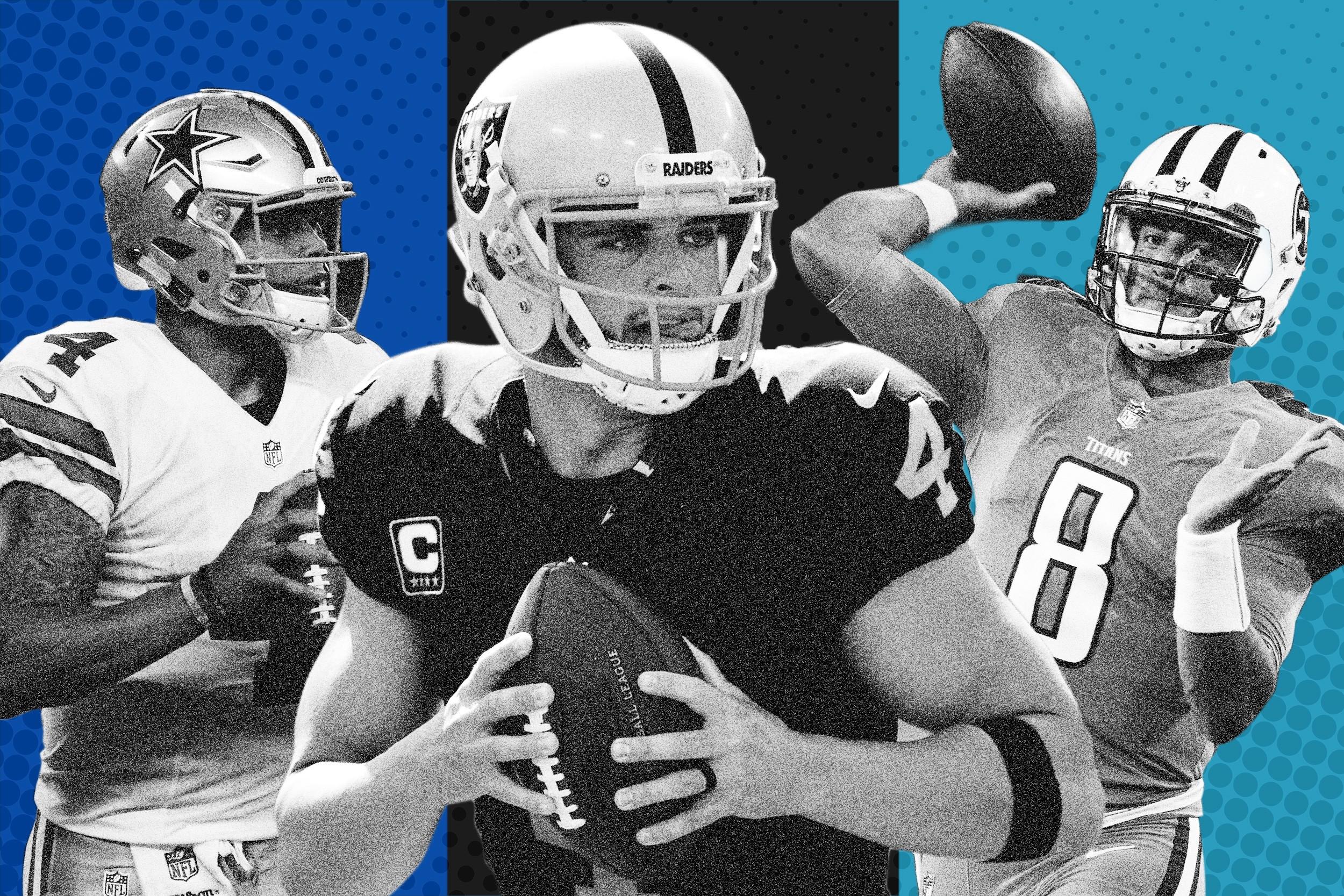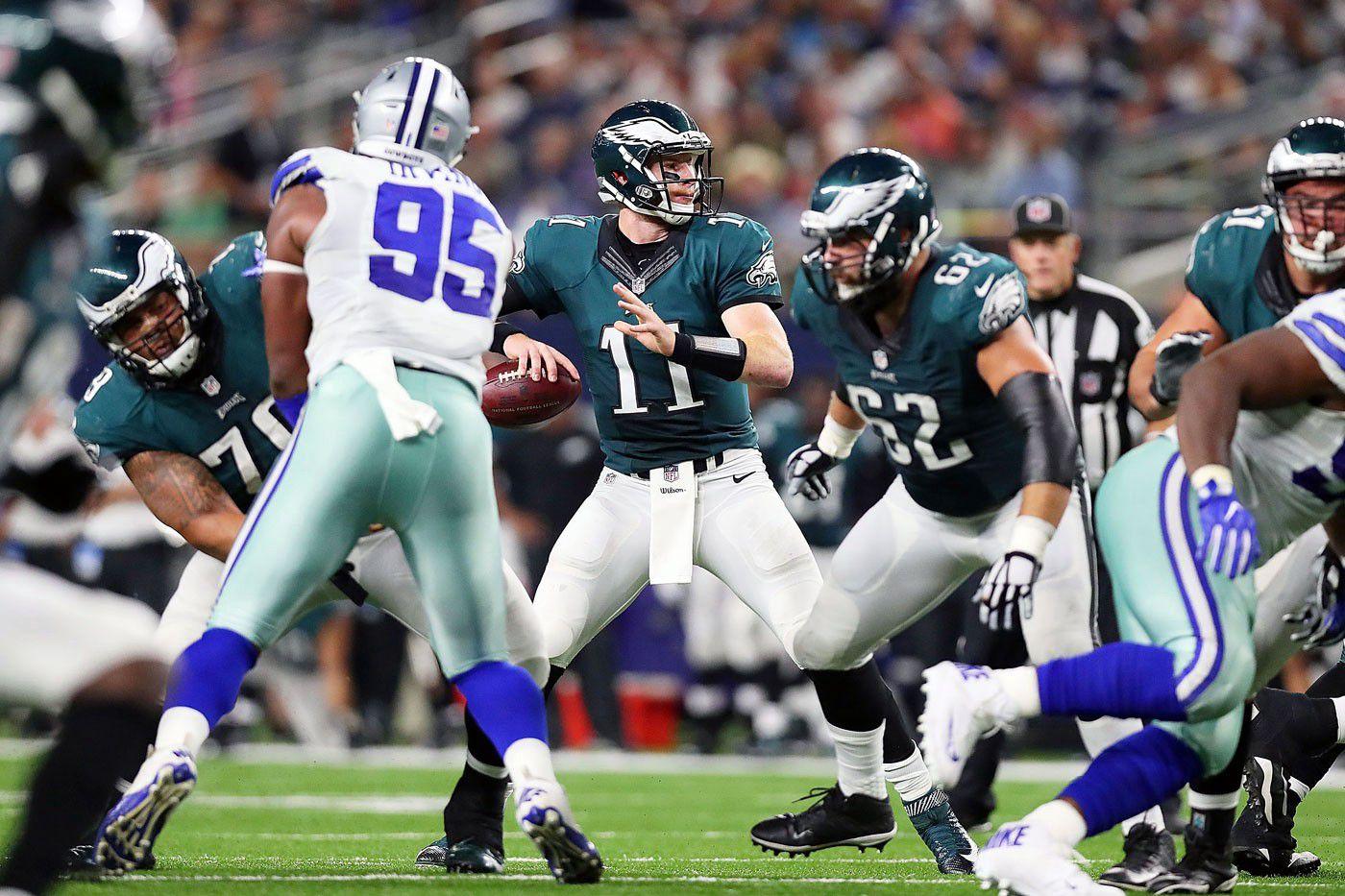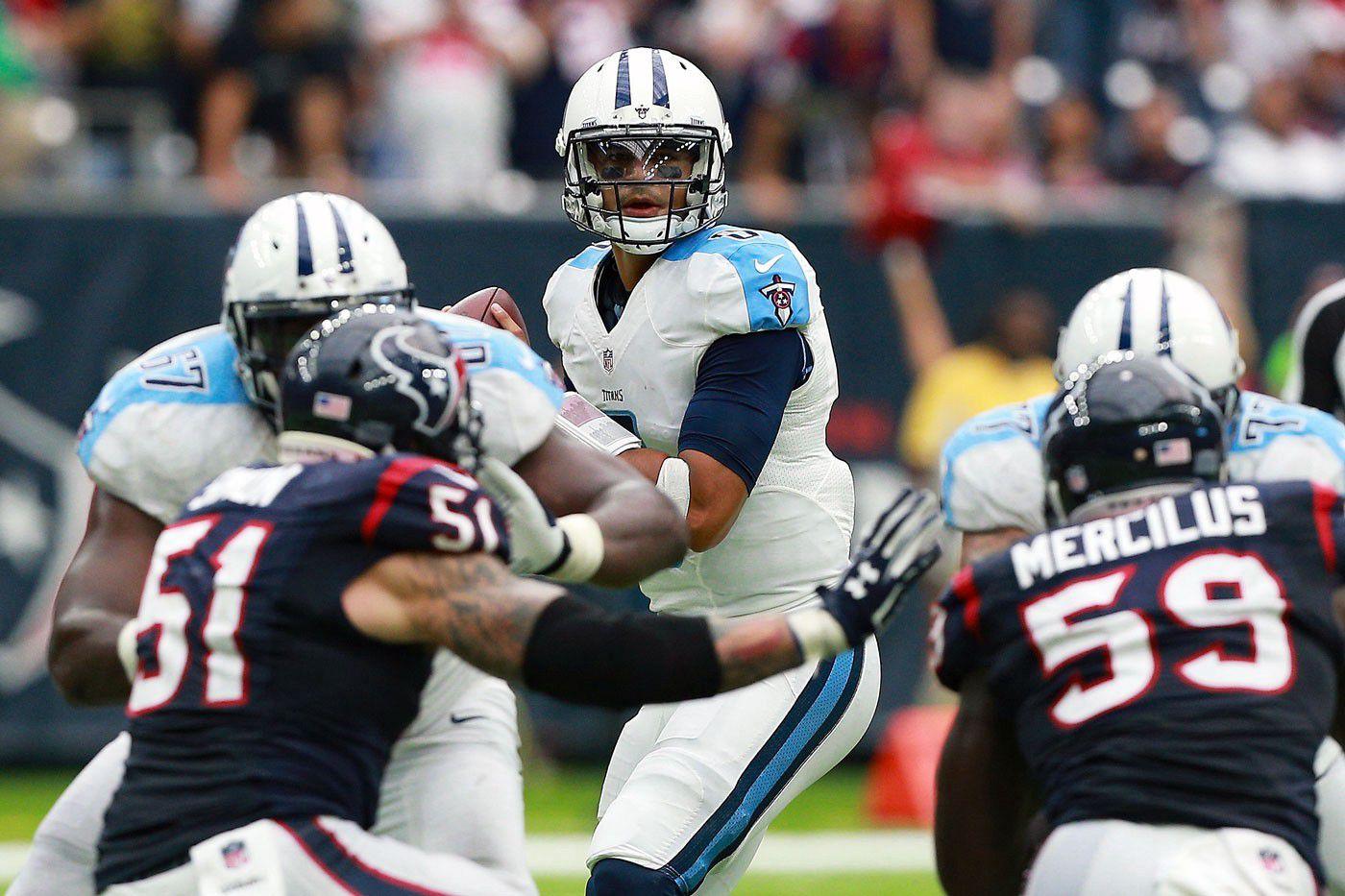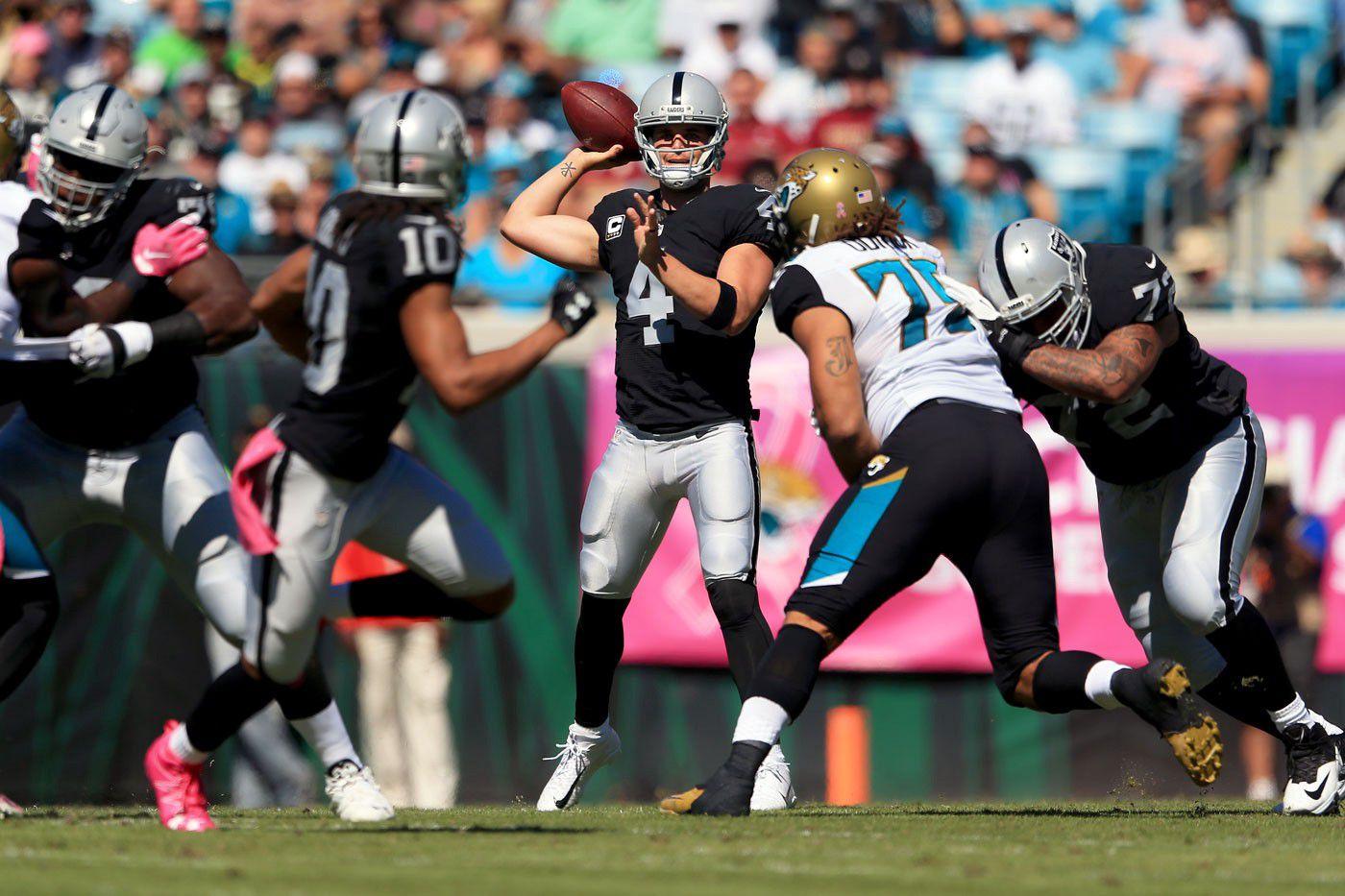The NFL’s Next Wave of Superstar QBs Remains Unclear, but One Player Is Pulling Away From the Pack
Andrew Luck and Russell Wilson headlined the 2012 quarterback draft class, the best crop the league has seen in years. Since then, though, a star at the position has yet to emerge. That’s changing with the play of some passers this fall — especially one in Oakland.
It didn’t take long for the quarterback draft class of 2012 to assert itself as the best in years. Considering the buzz that surrounded the players who went first and second overall, perhaps that was to be expected. Stanford’s Andrew Luck was heralded as the most promising QB prospect since Peyton Manning; ESPN’s draft analysts labeled him as a “once-in-a-generation player almost guaranteed to become an immediate star at the next level.” And by the time the draft rolled around, Baylor’s Robert Griffin III was considered a franchise-altering option in his own right, worthy of the king’s ransom that Washington paid the Rams for the right to take him with the no. 2 pick.
When the pair eventually hit the field, they almost instantly justified that adulation. Griffin was a revelation in his debut season, winning Offensive Rookie of the Year honors after piloting his team to a 10–6 record and an NFC East title while averaging 8.1 yards per pass attempt and rushing for 815 yards with seven touchdowns. Luck, meanwhile, took a Colts team that went 2–14 in 2011 and led it to an 11–5 finish and a playoff berth, looking the part of a transformational player from the beginning.
The play of those two alone would have been enough to separate that quarterback class from many others, but Russell Wilson is the one who puts it over the top. Ryan Tannehill (taken no. 8 overall) has had a middling career while bouncing among four offensive coordinators, and Griffin’s trajectory since his incredible rookie season has been tragic. But with Luck playing the best football of his career and Wilson (taken no. 75) cementing his reputation as one of the most talented quarterbacks in the NFL, the 2012 group has solidified itself as the gold standard of recent QB crops.
That’s especially true given the drafts that followed. The 2013 class of quarterbacks is among the most bizarre in NFL history. It was the first draft in 12 years that saw only one signal-caller taken in the first round, when EJ Manuel went 16th to the Bills and surprisingly edged the Jets’ Geno Smith as the first QB taken. Three quarterbacks from the ’13 draft — Manuel, Smith, and the Buccaneers’ Mike Glennon — were their team’s respective starters as rookies, but their reigns were all short-lived. Both Manuel and Glennon lasted one season at the helm. Smith lasted two. Three and a half years into their careers, no quarterback picked in 2013 has started more than 30 games, and another opportunity for any of them feels like a far-off reality.
Yet while the 2013 draft seems like an aberration, both in the way the league valued quarterbacks and in its ability to find them, the three drafts that have come since have produced similarly scattered results. Johnny Manziel is a cautionary tale all his own, but most of his 2014 draft mates — namely Blake Bortles (because of his play) and Teddy Bridgewater (because of injury) — have also failed to prove they’re viable long-term options. And despite the fanfare that preceded the top two picks in the 2015 class, Jameis Winston and Marcus Mariota, the jury is still out as to whether either former Heisman Trophy winner will emerge as an NFL superstar.
As it currently stands, there are more questions than answers regarding nearly every QB taken since Luck and Wilson came into the league. With the NFL’s mainstay passers all hitting their mid-to-late-30s, a void is looming at the position, and uncertainty remains as to which young passer is capable of filling it.

Years from now, when analyzing what the Rams and Eagles gave up to acquire the rights to the first and second picks in the 2016 draft, people will probably think that Jared Goff and Carson Wentz were can’t-miss prospects coming out of college. They’ll be wrong, no matter how both players’ careers ultimately play out.

Unlike Luck-Griffin and Winston-Mariota, Goff and Wentz were never seen as guarantees to be the first two picks this spring. For years, the quarterbacks taken at the top of the draft were college football superstars — national champions and shoo-ins at Heisman ceremonies. Goff and Wentz were neither. The former was an Air Raid disciple who carried a Pac-12 also-ran to bowl eligibility; the latter was an FCS star who couldn’t crack the starting lineup until his junior season. For the Colts and Buccaneers, taking Luck and Winston was an obligation — in the Colts’ case, one that meant cutting ties with Manning. For the Rams, moving up to take Goff at no. 1 was an act of desperation.
Eight games into the 2016 season, it’s too early to panic about the Rams’ reluctance to start Goff, who’s yet to play a regular-season snap. Some believe that if he can’t beat out Case Keenum (he of the 8–to-10 touchdown-to-interception ratio) and provide a jolt to an offense ranked 31st in DVOA, then something must be seriously wrong. Goff’s learning curve from a simple, shotgun-heavy offense at Cal to an NFL system was always going to be steep, though. And part of the impatience that surrounds Goff likely stems from the early successes of the QBs selected after him.
Through his first three games, Wentz looked less like a rookie than a 10-year veteran. During the Eagles’ 3–0 start, he completed 64.7 percent of his passes while throwing five touchdowns against zero interceptions. That performance was partially attributable to a system that gave Wentz plenty of simple throws (no quarterback in the league has a shorter average length of completion that Wentz’s 4.97 yards), but a lot of it was the result of Wentz playing beyond his years.
He handled Philadelphia’s offense better than anyone could have expected, especially given that unit’s lack of weapons on the outside. Philly’s scheme lacked punch, but Wentz’s decision-making and execution under pressure made it thrive. As opposing teams have gathered more tape on Wentz, his numbers have dipped; the Eagles have dropped three of their last four, and the monuments being constructed in Wentz’s honor have likely been put on hold. Still, with the Eagles sitting at 4–3 and Wentz proving himself more than capable, it’s easy to see why teams scrambling to find a promising young quarterback might look on with envy.
Wentzmania may be cooling off, but I’m pretty sure that most Cowboys fans have come to view Dak Prescott as some sort of deity. Like Wentz (who became the Eagles starter only after Sam Bradford was dealt to Minnesota), Prescott assumed the starting job in Dallas because of extenuating circumstances, as Tony Romo broke a bone in his back during a preseason game in August. But what Prescott has accomplished in relief has been astonishing. The 23-year-old fourth-round pick (no. 135 overall) has completed 65.2 percent of his passes, thrown nine touchdowns against just two picks, and lifted the Cowboys’ offense to the no. 2 ranking in DVOA.
After Romo went down, the initial hope was that Prescott — with the help of Dez Bryant, Ezekiel Elliott, and the league’s premier offensive line — could shepherd the offense to respectability and keep Dallas afloat until Romo’s return. Instead, he’s transformed that unit into a group of pillagers that lays waste to all in its path, leading the Cowboys to an NFC-best 6–1 start. Eight weeks ago, it seemed unthinkable that Romo wouldn’t be handed the keys when he was healthy; now, even owner Jerry Jones — who for all we know may have legally adopted Romo at some point — has softened his stance.
Finding a parallel to what’s brewing in Dallas is next to impossible. The comparison that has been made most often is Tom Brady supplanting Drew Bledsoe in New England in 2001, but when Brady took over, Bledsoe was far from the quarterback that Romo was when he was last on the field. Prescott has become a real-life Willie Beamen, if only Beamen spouted constant platitudes instead of starring in poolside rap videos. Beamen would have not only attended the Kanye West show that Prescott skipped earlier this fall — he would have found his way on stage during “Famous.”
Prescott has been outstanding in nearly every facet. His 8.43 adjusted yards per attempt puts him third all time among rookie quarterbacks, behind only Griffin and the Rams’ Marc Bulger. The Cowboys’ running game remains their greatest strength, but the team was without an injured Bryant for three games, and Dallas still ranks third in passing DVOA. If there’s one shortcoming Prescott has shown, it’s been that his downfield passing game is wanting. That was on full display against the Eagles last Sunday, when Prescott turned in the worst start of his young career (19-of-39 for 287 yards, with two touchdowns and an interception). Any argument for Romo reclaiming the job focuses on the Dallas passing attack reaching its ceiling.
No matter how that situation plays out, though, Prescott appears to be the Cowboys QB of the future, a position that draws as much attention and scrutiny as any in sports. It’s dangerous to assume that early-career production is a guarantee of what’s to come (see Griffin, Robert; and Kaepernick, Colin), but to this point both Wentz and Prescott have experienced heights as rookies that no player from the previous two classes has seen. They’re part of the conversation about the best quarterbacks to emerge since the 2012 draft, and considering what was expected of the top two QBs in 2015, that’s shocking.

The only drama surrounding the top of the 2015 draft was whether Winston or Mariota would be the first player chosen. The duo was the surest bet to go no. 1 and no. 2 since the Luck-Griffin draft, and Tampa Bay elected to go with Winston and his preternatural anticipation over Mariota and the intriguing skill set he flashed at Oregon.

When the two rookies clashed in Week 1 last season, it seemed as if Mariota — who threw four touchdowns in just 15 attempts in that game — might become the next sensation to take over the NFL. As it turns out, though, Tennessee’s offense wasn’t a sleeping giant that only Mariota could awaken. Injuries cost him four starts in 2015, and the Titans struggled to move the ball even when he was on the field. They finished the season dead last in offensive DVOA; Mariota was sacked on a staggering 9.3 percent of his dropbacks, the highest rate in the league among QBs who started more than half of their team’s games.
New general manager Jon Robinson’s response was to do all he could this offseason to insulate his franchise quarterback. The Titans retooled their running game by trading for DeMarco Murray and drafting Heisman winner Derrick Henry in the second round of the 2016 draft. They traded up in the first round to select Michigan State tackle Jack Conklin and signed former Texans center Ben Jones in free agency. They made an all-out effort to protect Mariota, with both better play up front and a running game that could form the basis of the offense.
The idea that a former spread quarterback would be aided by heavier packages and a downhill running game was met with mixed reviews. So far, it’s produced mixed results. There’s no denying that Tennessee’s offense is considerably better than it was last year. The Titans are ninth in offensive DVOA, a massive leap from the league’s cellar. But as Football Outsiders’ Tom Gower pointed out, that can be misleading. The Titans’ ability to convert on third down (third-highest percentage in the NFL) and punch the ball into the end zone (fourth in touchdowns per red zone drive) help to bolster that number, but watching this offense, it’s clear that Tennessee lacks explosiveness throwing the ball.
The design of the offense and the supporting cast are partially to blame for those woes (the craze surrounding fifth-round rookie Tajae Sharpe this preseason is all anyone needs to know about the Titans’ desperation at wide receiver), but 20 starts into his career, Mariota looks a lot like the player he was a season ago. His numbers through eight games are almost identical to his rookie production: 7.6 yards per attempt in both seasons; a 63.3 completion percentage, up from 62.2; and a 2.4 percent interception rate, compared to last season’s 2.7. The main difference is he’s been sacked about 50 percent less often (9.3 percent to 4.6). Without horrid pass protection sabotaging drives — and with a dangerous ground game to lean on — the Titans have jumped to competency, but Mariota has yet to prove he’s the type of QB who could become one of the faces of the league.
The same could be said of Winston, whose lack of progress between his first and second seasons has been even more disappointing. A slew of factors pointed to a leap for Winston and the Bucs offense this fall. In 2015, Tampa finished fifth in both yards per drive (34.6) and plays per drive (6.2), signs this offense was capable of sustaining possessions and moving the ball. Its two big issues — turnovers and penalties — seemed correctable, but so far they continue to plague the group. Winston’s habit of throwing interceptions seems less like the rookie blues and more symptomatic of how he plays.
Winston comfortably leads the league in average pass distance, a reality brought on by both head coach Dirk Koetter’s play designs and Winston’s let-it-rip approach. Yet the Bucs’ desire to push the ball downfield and the questionable decisions that it produces have actually led to Winston turning the ball over more often in 2016. After posting a 2.8 percent interception rate as a rookie, Winston is at 3.3 percent through seven games this fall. The picks have helped ground a Tampa Bay offense that ranks 22nd in DVOA and is down in nearly every major category from where it was a season ago. The hope was that Winston would make the same type of jump that QBs like Luck did from their first year to their second, but at this point, the returns have been underwhelming.
It’s telling that, at the midseason point, Trevor Siemian (no. 250), taken six rounds after both Winston and Mariota, has had as much success as any quarterback from the 2015 class. Where the former Heisman winners were supposed to take the league by storm, Siemian’s job is to keep the seat warm in Denver until rookie Paxton Lynch (the no. 26 pick this spring) is ready to assume his presumed future role as the Broncos’ starter.

If we’re ready to make any definitive judgments about the quarterbacks taken after the 2012 draft, they’re about the 2014 crop of Bortles (no. 3 overall), Bridgewater (no. 32), and Derek Carr (no. 36). Coming into the season, it seemed as if 2016 would be an illuminating year for all three.

Bridgewater had been adequate in his first two years in Minnesota, but with the Vikings seeking to return to the postseason and Adrian Peterson’s time with the franchise likely winding down, it felt as if this would be the year Bridgewater took the reins of the offense. That chance was snatched away before it even began. On August 30, he suffered a knee injury as gruesome as knee injuries come. In a scene so haunting that only a few of his teammates are willing to discuss it, he dislocated his knee and tore his ACL. The damage is apparently bad enough that Bridgewater’s status for next season remains in doubt, a matter that’s further complicated by Sam Bradford’s contract (which extends through the 2017 season) and level of play throughout Minnesota’s 5–2 start.
In Jacksonville, Bortles helped the Jaguars jump from 31st to 21st in DVOA during his second campaign in 2015, but he gained a reputation as a Garbage Time King that’s deserved. This fall, for the second consecutive year, a disproportionate amount of his production has come with the 2–5 Jaguars in desperation mode. Last season, 16 of Bortles’s 35 touchdowns came with Jacksonville trailing by at least nine points, and nine came with the Jags down by more than seven in the fourth quarter. This year has brought more of the same. Five of Bortles’s scores have come when his team was down by more than seven points in the final frame.
The Jaguars offense has regressed, slipping from 21st in DVOA to 28th, and their ineptitude on that side of the ball recently cost coordinator Greg Olson his job. But the Jags are more than a coaching change away from becoming an above-average offense. Through his first 37 games, Bortles has the 14th-worst adjusted yards per attempt since the merger for players with at least 1,000 attempts. Given the seasons that Matthew Stafford and Matt Ryan are enjoying, patience has become increasingly key when evaluating quarterbacks, but the turnaround it’d take for Bortles to become a top-level QB would be historic.
Among the starting quarterbacks from that class, that leaves only Carr, whose Raiders have been one of the breakout stories of the first half of this season. With Oakland’s 6–2 start and Carr’s excellent stats — 2,321 yards, 17 touchdowns, three interceptions, and a 66.3 percent completion rate — the 25-year-old has generated some understandable MVP buzz. The Raiders rank fourth in offensive DVOA, and it’s hard to imagine them being anywhere close to that level without Carr under center.
On the surface, Carr’s numbers place him among the best quarterbacks in football. He’s fifth in yards, 10th in completion percentage, and tied with Aaron Rodgers for third in touchdown passes, behind only Ryan and Drew Brees. By other measures, though, the distance between Carr and the league’s best QBs becomes clearer.
Carr ranks 19th in yards per attempt (7.2), wedged between noted stars Case Keenum and Cody Kessler. That isn’t the end-all of passing metrics, but it does point to Oakland’s style of play in the passing game. For a QB who has the type of cannon Carr possesses, he can be oddly conservative. His absurd bombs (like his on-the-run, 56-yard rocket shot to Michael Crabtree against Jacksonville) are memorable, but Carr is often content to attack the underneath areas of a defense. Only eight quarterbacks have a shorter average pass length in 2016. After watching the Raiders, that isn’t surprising.
The shots Carr typically takes often involve a receiver running open down the field. With his arm, those plays look beautiful when they connect. Yet his approach in the passing game is noticeably risk averse. That leads to very few interceptions, but it also lends to a hit-or-miss feel to the Raiders’ offense. Oakland ranks just 27th in plays per drive (5.7) and 17th in three-and-outs per drive (21.3 percent of the time). Relative to some of the NFL’s other top offenses (Dallas, New Orleans, Atlanta), the Raiders haven’t been nearly as consistent moving the ball.
At this point, though, that’s nitpicking. There may be a lingering fear among Carr supporters that he could experience a drop-off like the one he did in the final eight games of last season, when he threw 13 touchdowns against nine interceptions and averaged just 6.3 yards per attempt, but it isn’t likely. Among all his improvements in 2016, Carr’s ability to deal with pressure may be the most significant, and given the talent that the Raiders have up front, the cushy environment he’s had so far this year should continue.
If it does, the high-flying moments the Raiders have had will, too, and Carr’s could solidify his place among the league’s preeminent QBs. The Raiders passer has his faults, but what he’s shown this season is more than enough to earn him the title of the best young QB to come along since Luck and Wilson. Although uncertainty rules when it comes to the others, it’s time to say the Raiders have found their man. As a slew of Hall of Fame–caliber quarterbacks march toward the end of their careers, Carr is wading into his prime, looking poised to take his place among the NFL’s best.